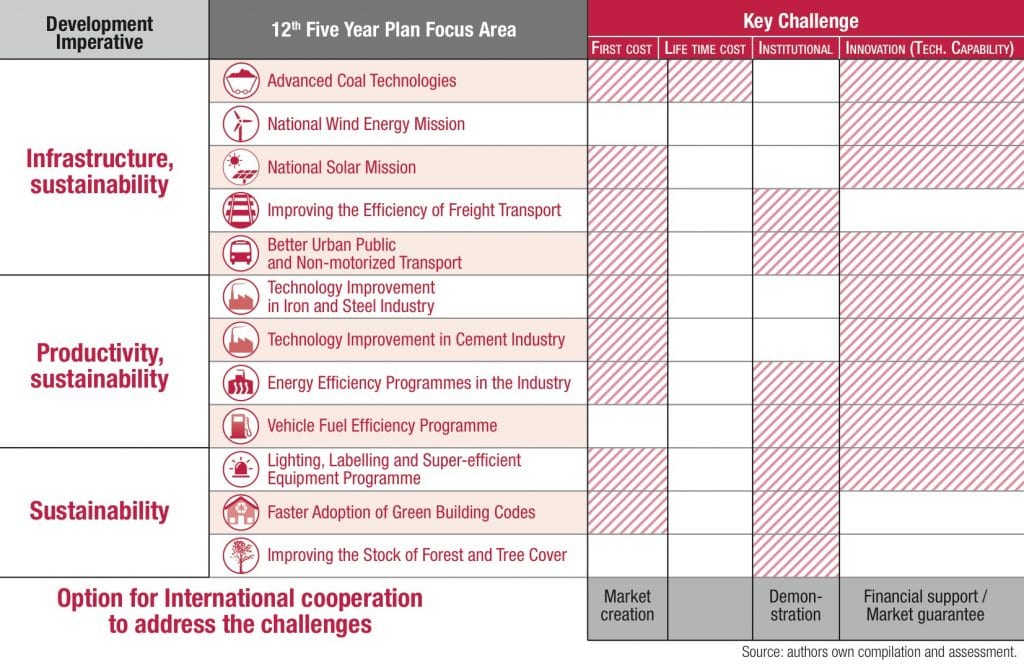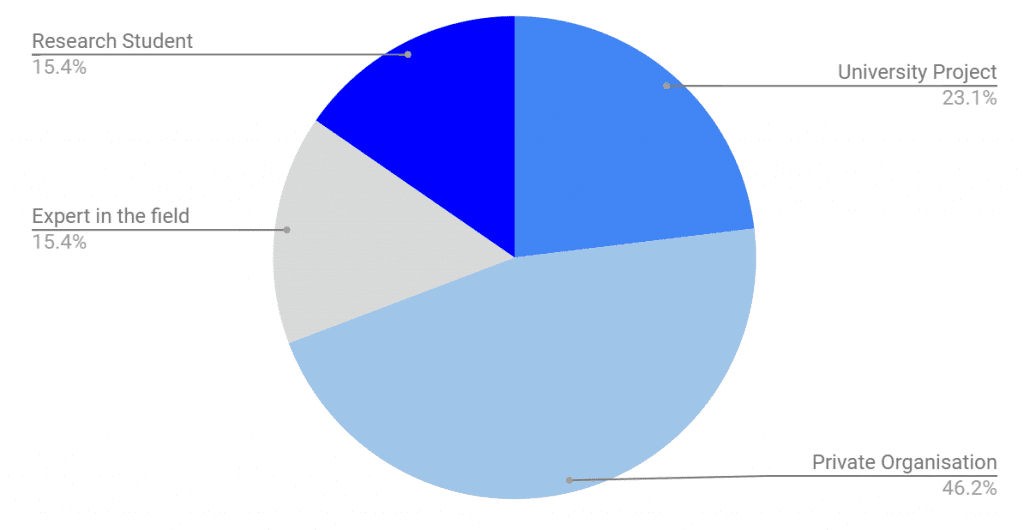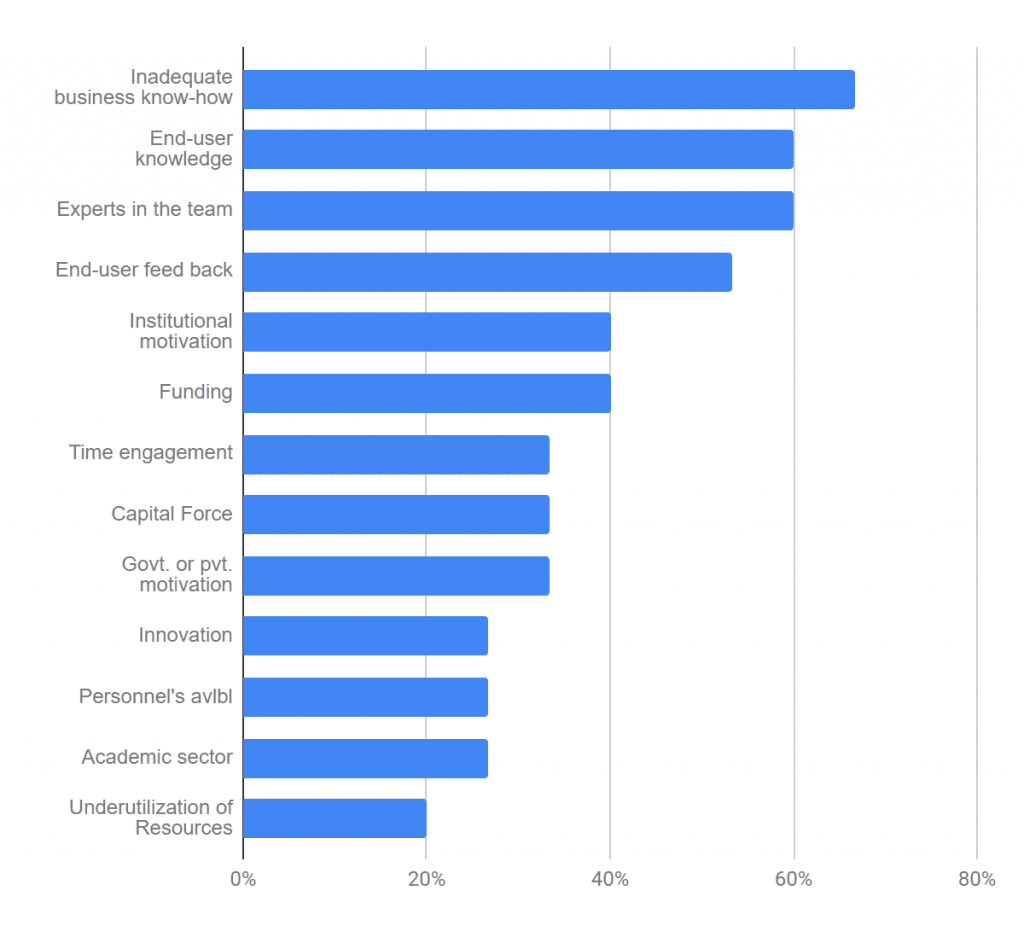This report is available for full download to PDF.
Executive Summary
The sustainable development sector in India has been prioritized and augmented with several technological interventions over the last decade. However, it has been observed that many of the technical innovations are failing at various stages resulting in poor dissemination of technology and below the expected performance of the sector at large. In order to bridge this gap, questions were presented to stakeholders involved in the process of technology dissemination in the form of structured interviews to gain insights into challenges, issues, and barriers faced in sustainable development. Results showcase 12 themes including: (1) inadequate business know-how, (2) end-user knowledge, (3) experts on the team, (4) end-user feedback, (5) institutional motivation, (6) funding, (7) time engagement, (8) capital force, (9) government and/or private motivation, (10) personnel’s availability, (11) academic sector, and (12) underutilization of resources. Ultimately, assistance from the government (e.g. market-enabling policies and funding opportunities) and the private sector (e.g. market and business expertise) could greatly improve the rate of innovation transfer to the public market.
Introduction
National Development Goals
The 2030 Sustainable Development Goals (SDGs), authored and adopted by all United Nations member states to build a more prosperous world while protecting the environment, consist of 17 goals that cut across various sectors such as agriculture, water, sanitation, health, and energy. While India has prioritized key sectors for interventions through policy and funding structures, several grassroots innovators, development organizations, and scientific organizations have responded to this global call for sustainable development through the design of technological innovations. The Directive Principles of State Policy of the Constitution of India, which are fundamental in the governance of the country, specifically provide a constitutional obligation for the state to work towards the SDGs [1]. India, in its twelfth five-year plan, as shown in Figure 1, has sustainable development at its core. The country specifically incorporated the SDGs into their national strategy by establishing the National Development Goals [2]. The National Development Goals focus on the following primary categories: economic growth, poverty eradication and employment, education, health, infrastructure, and environment and sustainability. These goals have an important role in defining the roadmap in using infrastructure as a tool to enhance productivity and sustainability in the country.
Energy Sector
It is estimated that India’s energy supply requirements will range from 1,146 million toe to 1,700 million toe by 2030, compared to 819 million toe in 2011-12, which is creating a hurdle on the road to sustainability [2]. As per the India Brand Equity Foundation (IBEF), India ranked 4th in the Asia Pacific region out of 25 nations on an index that measures their overall power requirements, largely due to recent economic development and population growth [3]. India’s energy production is a mix of renewable and exhaustible resources including coal, oil, natural gas, wind, solar, and biomass; among others [4]. With population ever increasing, deforestation on the rise, and continued economic development, implementing sustainable energy solutions must continue to be a priority for the county. Funding for these innovations can be a challenge, however, there are a number of organizations such as the Shell Foundation working towards providing funding and support for startups and innovators.
Health Sector
With India’s growing population, the demand for effective healthcare technologies has been identified as an area of both concern and interest. The annual healthcare budget only spends 85 USD per person, which is amongst the lowest if compared to other countries, as reported by BioSpectrum India [5]. On account of deficit energy supply, India is lacking adequate medical healthcare facilities in terms of infrastructure, manpower, and involvement as per the planning commission of India [1]. As projected by the Planning Commission of India, the challenges for India in global health problems are more predominant as compared to other countries. Even though its share in world population was 17 percent only, the country has a share of 23 percent of child deaths, 26 percent in childhood vaccine preventable deaths, 20 percent in malarial deaths, 68 percent in leprosy cases, and 30 percent in tuberculosis cases [6]. Support from government entities has been instrumental in India’s health innovation sector, including proactive government funding initiatives such as Biotechnology Ignition Grant Scheme (BIG) from Biotechnology Industry Research Assistance Council.
Barriers to Innovation
A common approach adopted by Indian research institutions has been to transfer proven solutions and early prototypes to for-profit entrepreneurs for further development and privatization. It has been observed by Entrepreneurial India [7], however, that many technologies are not ultimately transferred to market and commercialized, preventing innovative – and potentially life-saving – technology from reaching the public. In India, the primary reason for startup failure is due to a lack of transferring and scaling of innovations; despite the presence of high-end technical institutes and labs across the country. Our research seeks to further contextualize and challenge these findings through an analysis of root causes and challenges of technology transfer and commercialization of technology for development. An innovative breakthrough in technology may or may not result in sustainable findings. There are a number of social entrepreneur ventures that value important need of the society at large [8]. The challenges pertaining to these problems can only be addressed if we can foresee the technological gaps in the transfer of technology for development [9]. Prior research has shown the financial gaps needed to bridge a path towards the SDGs in India, which is extensively documented by Technology and Action for Rural Advancement in 2015 [10]. As per the government of India’s Programme on Sustainable Development Goals, the health and energy sectors are lacking adequate supervision in terms of business know-how, end-user knowledge and feedback, and experts in the team among others. According to IBM Institute for Business Value, the reason most Indian startups fail is lack of pioneering innovation while almost one-third of Indian leaders agree that ecosystems can help accelerate innovation as per their surveys [7].
Research Objectives
The objective of this research is to understand the factors concerning the transfer of technology to market in India, specifically in the Energy and Health sectors. This study is a joint project by Engineering for Change (E4C) and the Centre for Social Innovation & Entrepreneurship (CSIE) at Indian Institute of Technology (IIT) Madras. E4C is a knowledge organization, digital platform and global community of organizations and individuals dedicated to promoting essential technologies for underserved communities worldwide. CSIE works closely with social enterprises-particularly livelihood organizations and artisan clusters to build their capacities in organizational and business development in India.
Over the course of three weeks, interviews were conducted with representatives from research institutes and private entrepreneurs in India to gain insight into challenges, issues, and barriers they encountered while transferring technologies to the market. The purpose of each interview was to understand the root causes of the observed phenomena. The research method was designed to elicit responses from the stakeholders involved in the process of dissemination of a product or service. The results are discussed in order to aid policy makers, research institutions and entrepreneurs to understand the gaps in the deployment of sustainable technologies.
Methods
A list of stakeholders, including faculty and staff at research institutions, startups, and private companies was curated by the research team. Thirty stakeholders were selected based on their potential to provide relevant information regarding failure and success factors for innovation in health and energy sectors (listed in Appendix 1. Emails regarding the objective of the study were sent out to the identified stakeholders. Fifteen individuals responded showing their interest in the study. Out of those fifteen, seven were from Healthcare domain and eight were from Energy sector. The breakdown of interview participants is shown in Figure 2. Next, individual interviews with stakeholders were conducted by two of the lead authors, both native to India, via video calls (n=4), phone calls (n=2) and in-person meetings (n=7), with questions aimed to gain insights on barriers and enabling factors of deployment of sustainable technologies, as well as solutions or expectations that they have in mind. The complete list of interview questions is provided in Appendix 2. Notes were taken during the interviews and responses were organized inductively, based on identified themes. The detailed experiences of the interviewees that either resulted in successful commercialization or failure to reach market have been condensed into a number of categories in order to distinguish major hurdles from the lesser ones. The gaps have been analyzed by accumulating and enumbering responses of a type into the defined categories to gain insights into challenges, issues, and barriers in the deployment of sustainable technologies.
Barriers to Technology Transfer in India
From the interviews, 12 primary themes regarding factors for innovation success and/or failure emerged. Figure 3 displays the percentage of participants who identified these themes (out of 15 respondents), which are described below:
1. Inadequate business know-how. The need for financial and market advice has been felt by a number of informants, and there was an overwhelming need for support from individuals from the business domain to ensure better market analysis and reach.
2. End-user knowledge. The founders and developers of the technologies emphasized the importance of researching and integrating end-user knowledge and experiences into the product design. Experts in both of the sectors of health and energy reiterated that a common failure of transfer was an emphasis on technology innovation rather than local demand (based on real end-user needs and desires), resulting in innovations that cannot effectively add value to people’s daily lifestyles and are left unused.
3. Experts in the team. Lacking the necessary experts to further develop and scale a technology can cause major issues in technical, business, and legal development; among others.
4. End-user feedback. Neglecting to receive and incorporate end-user feedback during the design, testing, and iteration phases of product development can lead to products that do not meet user needs or preference.
5. Institutional motivation. Research institutions, both private and academic, may have various motivations for innovation. Many academics are often more motivated by research, papers, patents, and grants rather than successful startups. This means they often do not spend the necessary time to understand the end-user or target market characteristics.
6. Funding. The data also trace the problem of failure in the transfer of sustainable technologies down to a lack of funding from government or non-government bodies. A report by Technology and Action for Rural Development further elaborates on this barrier in India [10].
7. Time engagement. Startups and product innovation can require a lot of time and commitment, which when insufficient, can lead to project failure.
8. Capital force. Lack of startup capital can cause a project to fail quite quickly, particularly if the innovation is moving from an academic institution to the market.
9. Government or private motivation. Not all products can survive on the market without public assistance. For some innovations, the most viable option to provide incentives for the buyer depends on the funding and financial support received from the government or corporations (e.g. subsidies on LPG cookstoves to discourage the use of biomass-burning stoves). Aligning the motivations of a startup with India’s National Development Goals, and gaining government support can be invaluable to product success.
10. Personnel’s availability. For innovations from student-led projects from academic institutions, individual contributors may be unavailable to continue working on the product upon graduating, often leading to a lack of transfer of the innovation.
11. Academic sector. Innovations that come from academic institutions are often on their own timeline, which is much slower than the private sector, causing discrepancies.
12. Underutilization of resources. The director of a renewable energy company recognized that infrastructural investment proved to be a large overhead cost for the nascent organisations and often due to a lack of resources and funds, labs and incubators cannot be maintained. Hence an opportunity to access labs and facilities of established institutes or companies would be extremely beneficial.
Innovation Strategies and Recommendations
From the twelve barriers, presented in the previous section, four themes emerge that play an imperative role in the transfer of technology to market, namely: understanding end-users, the level of government involvement, incorporating maintenance and business expertise, and assessing the differences between academic and market incentives.
Understanding end-users
Many issues arise when designers lack an understanding of their end-users but pursue the development of a product or prototype. The designer not only needs to ensure that the product adds value to the user, but also must consider the final training process and user-provision model that will be implemented. Our informants greatly advised innovators to learn the habits of the everyday life of the end-users and design the product accordingly. An essential approach for these interactions is to engage with users in their local language, to reduce the common preconception of alienation. It is also preferred for a product to have a certain amount of flexibility to allow retrofitting and user customisation depending on the location of deployment. Furthermore, products targeted for vulnerable sections of the society should be designed to either have the capacity to generate income or reduce expenditures and/or burdens.
Government involvement
While our informants mentioned a need for the government to restructure the source of loans for startups based on Sustainable Technologies and Rural Entrepreneurship, it is also necessary to recognize that these products are finding it almost impossible to reach out to the larger market in a country of 1.2 billion people by virtue of word of mouth. Organizations are in dire need of schemes, policies and events that create awareness and generate demand in the market for sustainable technologies. Incentives to drive the market and promote sustainable products, through the use of social media and platforms of mass media is expected to assist with this barrier in the future. Several interviewees shared the experience of failed attempts to receive funding, resulting in significant delay and hindrances during the deployment of the technology. The findings also shed light on a discrepancy on the tax system that results in manufacturers incurring more than 18% while making the product, but receiving just 5% while selling the product. Certain organisations feel the government should themselves be accepting of a shift from conventional technologies and also be catalysts for the public to realise the same. The government’s solar energy subsidies are primarily restricted to Solar PV cells and does not extend to one informant’s promising solar-cooking technology, for example. This observation underlines the fact that the sustainable sector is developing into a vast one, and focus on specific sub-sectors of energy sources (i.e. specific technologies) will eventually result in losing out on sustainable development opportunities.
Maintenance and business expertise
To plan for project longevity, designers must consider ongoing product maintenance and incorporate business/market expertise and support. The design of the technology and the business model must incorporate a reliable and trustworthy maintenance program. Furthermore, frequent interactions with the end-users can help startups gain knowledge to develop a unique and appropriate business model for their innovation. Along these lines, nine interviewees felt the need for personnel and/or an institution that could take full fledged initiative to move the technology to the market, so that the designers could focus their time on research, development, and production.
Organisations must also assess if they need to debunk existing prejudices toward sustainable products, which may have risen due to poorly designed predecessor technologies. The founder of an emerging private company believes that the negative word travels very fast, thus highlighting the need for robust products and good customer service. An approach that could enhance the deployment collaborations is to present a technology to a third party that focuses on appropriate business or marketing strategies. However, this third party might not know the target group and the product as well as the developers.
A unique problem addressed during the interview with a solar solutions company, was the margins of profit involved in distributing out-of-the-norm products. By the time such products reach the consumer at locations away from the production unit, the cost rises dramatically thus making it difficult to sell the product. Sales representatives in market places do not need to sell daily gadgets and amenities with as much explanation as new products require, often losing the customer’s interest. As suggested by one of the interviewees, a solution to this problem might be to develop open source data-base and platforms for comparison and information on these products, similar to the E4C Solutions Library, to kindle the interest and buying motivation of people. Online platforms can also help manufacturers develop synergies country and reduce costs of manufacturing through several collaborations and knowledge sharing.
Academic vs market incentives
Many technologies and innovations are being developed at Indian universities without focus on market demand, but with the goal of publishing papers and filing patents. Inspiring students to continue development and scaling of their university projects after their degree is completed is rare since they are often offered other higher paying jobs, or ones which match their personal interests. Additionally, a PhD scholar from one institute felt that collaboration between Indian institutes could be greatly improved (i.e. more sharing of knowledge, resources, and personnel).
Conclusion
This study focuses on identifying the various barriers and enablers for technology transfer in India. The questions posed to the interviewees who each have experience in the field of sustainable technologies and its deployment were developed in a way to allow the authors to extract the factors that are responsible for project failure and/or success. Mainly, it is recommended to understand and incorporate end-user experiences, align with government incentives and funding schemes, invest in maintenance and business models, and improve collaboration within organizations involved, including academic and private institutions. Ultimately, for India to reach their Sustainable Development Goals, these factors must be considered during the innovation process of sustainable technologies, particularly in the energy and health sector.
Edited by: Grace Burleson
Additional contribution: James Rajanayagam, Mariela Machado
References
[1] Research and Information System for Developing Countries, India and Sustainable Development Goals: The Way Forward, 2016
[2] Mathur, Ajay, Manish Kumar Shrivastava, The Pursuit of Sustainable Development in India, Building the Future We Want, 2015
[3] India Branch Equity Foundation, Power Sector in India, August 2019.
[4] India Energy Portal, India Energy Sector: An Overview
[5] Biospectrum Staff Writer, Healthcare Industry Expectations from Budget 2019, Biospectrum, January 25, 2019
[6] Central Bureau of Health Intelligence, National Health Profile 2015, Government of India, 2015.
[7] IBM Institute for Business Value, Entrepreneurial India, IBM Corporation, November 2016.
[8] Mair, Johanna, Ignasi Marti, Social Entrepreneurship Research: A Source of Exploitation, Prediction, and Delight. Journal of World Business, Volume 41, Issue 1, February 2006
[9] D’Cunha, Suparna Dutt, 90% of Indian Startup Will Fail Because of Lack of Innovation. Forbes.com, May 2017.
[10] Bhamra, Anshul, Jay Vishash, Binu K George, Achieving the Sustainable Development Goals in India: A Study of Financial Requirements and Gaps, Technology and Action for Rural Advancement, 2015.




No Comments.